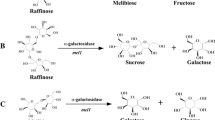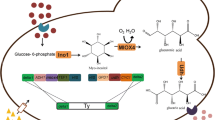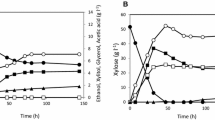Abstract
There are excessive by-products in the biocatalysis process of this whole-cell biocatalytic production of melibiose from raffinose with current Saccharomyces cerevisiae strains. To solve this problem, we constructed engineered strains based on a liquor yeast (S. cerevisiae) via gene deletion (mel1 gene), heterologous integration (fsy1 or/and ffzi1 gene from Candida magnoliae), and gene overexpression (gcr1 gene). Functional verification showed that deletion of the mel1 gene led to elimination of the reactions catalyzed by α-galactosidase, as well as elimination of the degradation of melibiose and the formation of galactose by-product. Insertion of the fsy1 or/and ffzi1 gene and overexpression of the gcr1 gene could contribute to fructose transport for enhancing the biopurification rate of the fructose by-product. Compared with the wild-type strain, the optimal engineered strain of MP8 (Δmel1::fsy1 cm ::ffzi1 cm ::gcr1 sc ) had improved about 30% on yield, 31% on productivity, and 36% on purity of the melibiose product.







Similar content being viewed by others
References
Bornscheuer UT, Huisman GW, Kazlauskas RJ, Lutz S, Moore JC, Robins K (2012) Engineering the third wave of biocatalysis. Nature 485(7397):185–194. doi:10.1038/nature11117
Cao P, Wang L, Zhou G, Wang Y, Chen Y (2014) Rapid assembly of multiple DNA fragments through direct transformation of PCR products into E. coli and Lactobacillus. Plasmid 76:40–46. doi:10.1016/j.plasmid.2014.09.002
de Carvalho CC (2011) Enzymatic and whole cell catalysis: finding new strategies for old processes. Biotechnol Adv 29(1):75–83. doi:10.1016/j.biotechadv.2010.09.001
de Jong BW, Shi S, Valle-Rodríguez JO, Siewers V, Nielsen J (2015) Metabolic pathway engineering for fatty acid ethyl ester production in Saccharomyces cerevisiae using stable chromosomal integration. J Ind Microbiol Biotechnol 42(3):477–486. doi:10.1007/s10295-014-1540-2
Deminoff SJ, Santangelo GM (2001) Rap1p requires Gcr1p and Gcr2p homodimers to activate ribosomal protein and glycolytic genes, respectively. Genetics 158(1):133–143
De Sousa HR, Spencer-Martins I, Gonçalves P (2004) Differential regulation by glucose and fructose of a gene encoding a specific fructose/H+ symporter in Saccharomyces sensu stricto yeasts. Yeast 21(6):519–530. doi:10.1002/yea.1118
Diezemann A, Boles E (2003) Functional characterization of the Frt1 sugar transporter and of fructose uptake in Kluyveromyces lactis. Curr Genet 43(4):281–288. doi:10.1007/s00294-003-0392-5
Ford CW (1972) Oligosaccharides from Phaseolus atropurpureus. Aust J Chem 25(4):889–892. doi:10.1071/CH9720889
Galeote V, Novo M, Salema-Oom M, Brion C, Valério E, Gonçalves P, Dequin S (2010) FSY1, a horizontally transferred gene in the Saccharomyces cerevisiae EC1118 wine yeast strain, encodes a high-affinity fructose/H+ symporter. Microbiology 156(12):3754–3761. doi:10.1099/mic.0.041673-0
Gonçalves P, de Sousa HR, Spencer-Martins I (2000) FSY1, a novel gene encoding a specific fructose/H+ symporter in the type strain of Saccharomyces carlsbergensis. J Bacteriol 182(19):5628–5630. doi:10.1128/JB.182.19.5628-5630.2000
Guimarães VM, de Rezende ST, Moreira MA, de Barros EG, Felix CR (2001) Characterization of α-galactosidases from germinating soybean seed and their use for hydrolysis of oligosaccharides. Phytochemistry 58(1):67–73. doi:10.1016/S0031-9422(01)00165-0
Hegemann JH, Heick SB (2011) Delete and repeat: a comprehensive tool kit for sequential gene knockout in the budding yeast Saccharomyces cerevisiae. In: Strain engineering: methods and protocols, pp 189–206. doi:10.1007/978-1-61779-197-0_12
Heljo VP, Filipe V, Romeijn S, Jiskoot W, Juppo AM (2013) Stability of rituximab in freeze-dried formulations containing trehalose or melibiose under different relative humidity atmospheres. J Pharm Sci 102(2):401–414. doi:10.1002/jps.23392
Hendrix DL, Peelen KK (1987) Artifacts in the analysis of plant tissues for soluble carbohydrates. Crop Sci 27(4):710–715. doi:10.2135/cropsci1987.0011183X002700040022x
Hossain GS, Li J, Shin HD, Liu L, Wang M, Du G, Chen J (2014) Improved production of α-ketoglutaric acid (α-KG) by a Bacillus subtilis whole-cell biocatalyst via engineering of l-amino acid deaminase and deletion of the α-KG utilization pathway. J Biotechnol 187:71–77. doi:10.1016/j.jbiotec.2014.07.431
Hudson CS, Harding TS (1915) The preparation of melibiose. J Am Chem Soc 37(12):2734–2736. doi:10.1021/ja02177a020
Kell DB, Swainston N, Pir P, Oliver SG (2015) Membrane transporter engineering in industrial biotechnology and whole cell biocatalysis. Trends Biotechnol 33(4):237–246. doi:10.1016/j.tibtech.2015.02.001
Kim D, Song JY, Hahn JS (2015) Improvement of glucose uptake rate and production of target chemicals by overexpressing hexose transporters and transcriptional activator Gcr1 in Saccharomyces cerevisiae. Appl Environ Microbiol 81(24):8392–8401. doi:10.1128/AEM.02056-15
Leandro MJ, Sychrová H, Prista C, Loureiro-Dias MC (2011) The osmotolerant fructophilic yeast Zygosaccharomyces rouxii employs two plasma-membrane fructose uptake systems belonging to a new family of yeast sugar transporters. Microbiology 157(2):601–608. doi:10.1099/mic.0.044446-0
Lee DH, Kim SJ, Seo JH (2014) Molecular cloning and characterization of two novel fructose-specific transporters from the osmotolerant and fructophilic yeast Candida magnoliae JH110. Appl Microbiol Biotechnol 98(8):3569–3578. doi:10.1007/s00253-013-5225-y
Lee GC, Lin CH, Tao YC, Yang JM, Hsu KC, Huang YJ (2015) The potential of lactulose and melibiose, two novel trehalase-indigestible and autophagy-inducing disaccharides, for polyQ-mediated neurodegenerative disease treatment. Neurotoxicology 48:120–130. doi:10.1016/j.neuro.2015.03.009
Naumov GI, Naumova ES, Korshunova IV, Jakobsen M (2002) Yeast comparative genetics: a new mel15 α-galactosidase gene of Saccharomyces cerevisiae. Russ J Genet 38(10):1127–1132
Pina C, Gonçalves P, Prista C, Loureiro-Dias MC (2004) Ffz1, a new transporter specific for fructose from Zygosaccharomyces bailii. Microbiol 150(7):2429–2433. doi:10.1099/mic.0.26979-0
Silman RW, Black LT, McGhee JE, Bangley EB (1980) Hydrolysis of raffinose in a hollow-fiber reactor using an unrefined mixture of α-galactosidase and invertase. Biotechnol Bioeng 22(3):533–541. doi:10.1002/bit.260220306
Song C, Zhao L, Ono S, Shimasaki C, Inoue M (2001) Production of poly (3-hydroxybutyrate-co-3-hydroxyvalerate) from cottonseed oil and valeric acid in batch culture of Ralstonia sp. strain JC-64. Appl Microbiol Biotechnol 94(2):169–178. doi:10.1385/ABAB:94:2:169
Tanaka S, Shinoki A, Hara H (2014) Melibiose, a non-digestible saccharide, promotes absorption of quercetin glycosides in rat small intestine with a novel mechanism. FASEB 28(1 Supplement):1044–1049
Tomita K, Nagura T, Okuhara Y, Nakajima-Adachi H, Shigematsu N, Aritsuka T (2007) Dietary melibiose regulates Th cell response and enhances the induction of oral tolerance. Biosci Biotechnol Biochem 71(11):2774–2780. doi:10.1271/bbb.70372
Weber N, Gorwa-Grauslund M, Carlquist M (2014) Exploiting cell metabolism for biocatalytic whole-cell transamination by recombinant Saccharomyces cerevisiae. Appl Microbiol Biotechnol 98(10):4615–4624. doi:10.1007/s00253-014-5576-z
Xiao M, Tanaka K, Qian XM, Yamamoto K, Kumagai H (2000) High-yield production and characterization of α-galactosidase from Bifidobacterium breve grown on raffinose. Biotechnol Lett 22(9):747–751. doi:10.1023/A:1005626228056
Zhou Y, Zhu Y, Dai L, Men Y, Wu J, Zhang J, Sun Y (2016) Efficiency analysis and mechanism Insight of that whole-cell biocatalytic production of melibiose from raffinose with Saccharomyces cerevisiae. Appl Biochem Biotechnol 2016:1–17. doi:10.1007/s12010-016-2220-7
Acknowledgements
This work was supported by the National High Technology Research and Development Program of China (No. 2013AA102102) and the National Natural Science Foundation of China (General Program, 31571793).
Author information
Authors and Affiliations
Corresponding authors
Ethics declarations
Conflict of interest
We declare that we have no financial or personal relationships with other people or organizations, which would inappropriately influence our work; there is no professional or other personal interest of any nature in any product, service, and/or company that could be construed as influencing the position presented in, or the review of, this manuscript.
Ethical approval
This article does not include any studies involving human participants or animals.
Electronic supplementary material
Below is the link to the electronic supplementary material.
Rights and permissions
About this article
Cite this article
Zhou, Y., Zhu, Y., Men, Y. et al. Construction of engineered Saccharomyces cerevisiae strain to improve that whole-cell biocatalytic production of melibiose from raffinose. J Ind Microbiol Biotechnol 44, 489–501 (2017). https://doi.org/10.1007/s10295-017-1901-8
Received:
Accepted:
Published:
Issue Date:
DOI: https://doi.org/10.1007/s10295-017-1901-8




